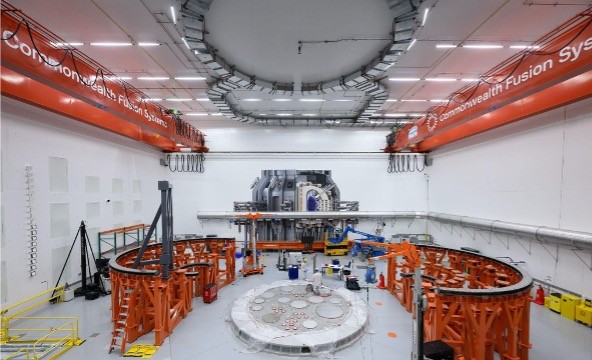
(Joe Paluska/ Commonwealth Fusion Systems)
The race for fusion energy is no sprint, it’s a marathon fueled by money and minds. And right now, America is running with only one shoe tied. China is outspending the United States 2 to 1 on the technology that could revolutionize how we power the world. Fusion could replace fossil fuels forever, but Washington is treating it like a science fair project.
Fusion has long been labeled “the energy of the future.” It works by replicating the same reaction that powers the sun: fusing light atomic nuclei into heavier nuclei and releasing energy in the process. The technological barriers have stumped the world’s brightest minds for generations but now, finally, that future seems to be within reach. Fusion energy, its boosters say, is no longer an “if,” but a “who” and “when.”
American scientists and funding have been at the forefront of fusion development for decades. But now, the United States faces two ticking clocks: the looming deadline of climate change and the race against overseas competition to finally commercialize fusion energy. Both demand urgent action, testing not only our technology but our will to lead. Carbon-free, virtually limitless electricity from abundant fuel is on the line. And yet, while American startups are on the verge of demonstrating viable fusion power, the broader national effort risks falling behind. To harness what could be the greatest energy leap forward since fire, we need a national vision, and a generation of minds trained to bring it to life.
Facing A Global Race Despite a Resource Gap
Fusion has been framed as a moonshot, on the brink of a breakthrough, for half a century without breaking through. But in the last decade, while the public eye shifted away, global private and public efforts have been chipping away at the obstacles that stand between theoretical physics and a fusion reactor plugged into the grid. The fusion moonshot’s countdown has begun, rapidly becoming an engineering and industrial challenge rather than a mystery of fundamental physics.
Leading the way is Commonwealth Fusion Systems (CFS) out of Devens, Massachusetts. CFS is an MIT-founded fusion powerhouse preparing to fire up its SPARC demonstration plant in 2027. SPARC is designed to demonstrate what physicists call net energy gain, and observers call the holy grail of fusion: getting more energy out of a fusion reaction than it takes to get it going. “As the world’s largest and leading commercial fusion energy company, Commonwealth Fusion Systems is on the verge of demonstrating commercial fusion is possible,” said chief marketing officer Joe Paluska in an interview. “In 2027, we’ll demonstrate more power out than in with our 100MW SPARC demonstration machine, which is the world’s most advanced next gen energy project.”
Yet even with remarkable technological progress, American fusion companies are competing on uneven footing. Not because they lack the science, but because America is underbuilding the system that can scale it.
As Paluska puts it, “Private capital alone won’t ensure that the US wins the global race for fusion.” China is estimated to be investing $2 billion annually in its domestic commercial fusion industry, he says. “In effect, that means CFS is competing with the industrial policy and
nation state of China.” One problem: fusion demands “patient” capital, the kind of long term, slow-to-pay-off investment that few venture funds are structured to provide on their own.
Paluska points to a proven approach: “We encourage the U.S. government to take a play from the program set up by NASA to support a domestic commercial launch vehicle industry, spawning market leaders including SpaceX and Blue Origin. A similar cost-share program led by DOE would support all of the U.S. domestic fusion startups in the global race for fusion.”
History offers cautionary examples of what’s at stake if the U.S. does not rise to this challenge. It seems like every time we ignore a foundational technology, we end up handing it over to another country, usually China. For example, solar. American labs helped invent modern photovoltaics, but China now dominates the global market through sustained investment and industrial planning. Similarly with computer chips, the United States pioneered the semiconductor industry but offshored most of its manufacturing capacity to Taiwan by the 2000s. Today, the U.S. is scrambling to restore domestic chip production with emergency legislation.
The risk is that we repeat the same mistake with fusion energy. Skeptics argue that fusion is still too far off, too complex, too costly—but so were semiconductors in 1970. The problem isn’t that fusion is unproven. It’s that we haven’t yet built the industrial foundation necessary to scale early applications and support future ones.
“The U.S. needs sustained public investment in fusion not just to stay competitive,” says Greg Piefer, whose Janesville, Wisconsin SHINE Technologies is developing fusion applications from medical isotope production to grid-scale power. A federal program is also needed “to build the industrial capabilities required to make fusion economically viable at scale.” If we don’t invest in that infrastructure now, Piefer and other fusion leaders say, we may win the science and lose the market.
“For decades we’ve focused fusion funding on scientific cooperation and nuclear deterrence,” notes fusion innovator Zap Energy’s communications head Andy Freeberg. But the field needs a strategic shift. Zap has developed advanced reactor technology, “but if the U.S. wants to reap the rewards of its decades of leadership and investment in fusion,” Freeberg says, “we’ll need to change our mindset.” Realizing fusion’s potential will require not just continued collaboration, he says, but a more ambitious and diversified plan. “We need to go bigger, we need to foster competition along with cooperation, and we need to leverage both public and private dollars with guidance from fusion’s most informed and least prejudicial experts.” Despite the technical and financial hurdles ahead, Freeberg believes the potential rewards are too great to ignore. “Fusion has the potential to be one of the most important technologies humans have ever developed and we have to address its challenges head-on without fear of failure.”
The window to act is still open for now, industry observers say. Unlike semiconductors or solar, fusion is at the very beginning of its commercialization arc. That means the U.S. still has a chance to lead and benefit from deployment if it invests in the infrastructure, workforce, and institutions that will shape this emerging industry. The opportunity is ours to seize, but it won’t happen without the dollars and the minds to make it real. Either we invest now, fusion leaders say, or spend the next hundred years buying back the future from those who did.
Stanford Can’t Sit This One Out
Stanford University has made a habit of pioneering technological breakthroughs. Google, Yahoo!, Hewlett-Packard, Cisco Systems, Nvidia, Netflix, DoorDash, PayPal, Instagram, LinkedIn, and Snapchat were all launched by Stanford students, faculty, or alumni, turning campus ideas into global tech giants. These technologies began as ambitious concepts in dorm rooms, lounges, and lecture halls, and went on to disrupt industries, redefine business models, and sharpen the cutting edge of progress. Yet even at a university known for bold bets and disruptive ideas, some frontiers remain surprisingly underexplored. The next trillion-dollar industry is being born, and Stanford might sleep through it. As fusion energy moves from science fiction to engineering fact, one of the most promising solutions for addressing the climate crisis is still flying under Stanford’s radar.
Unlike universities like MIT, Berkeley, and Penn State, which have dedicated nuclear engineering departments, Stanford does not currently offer a comprehensive program in this field. Given its leadership in climate and sustainability science research, in energy systems, and Stanford’s SLAC National Accelerator Laboratory’s cutting-edge expertise in advanced particle physics, Stanford is positioned to create a high-caliber program focused on nuclear technology. Doing so would help fill a critical national gap in training fusion scientists, engineers, and policymakers. Fusion could make electricity cheap, clean, and virtually limitless. So why isn’t Stanford training the people who will build it? We won’t get a second chance to lead the energy breakthrough.
“Private fusion companies need deep integration with” universities and other research institutions, says SHINE Technologies’ Piefer. It’s the only way “to tackle the scale of challenges involved in fusion development.” Fusion’s success depends not only on breakthroughs in physics, but also on advanced manufacturing, robotics, data science, energy policy, and materials durability under extreme conditions. Universities like Stanford are essential to weaving together those threads, producing graduates who can move between laboratory science, government, and startup environments.
Fusion, it turns out, is not a moonshot. It’s much, much bigger. It’s a sunshot: promising limitless, clean power by replicating the sun itself. But will the U.S.—and Stanford—lead this revolution or watch it unfold from the sidelines? We have the choice now whether we want to be a buyer of fusion electrons, or a seller.

